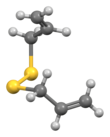
Back ثنائي كبريتيد ثنائي الأليل Arabic دیآلیل دیسولفید AZB Diallyldisulfid German Dualila dusulfido Esperanto دیآلیل دیسولفید Persian Disulfure d'allyle French Diallil-diszulfid Hungarian Dialil disulfida ID Disolfuro di diallile Italian 二硫化アリル Japanese
| |||
| Names | |||
|---|---|---|---|
| Preferred IUPAC name
3-[(Prop-2-en-1-yl)disulfanyl]prop-1-ene | |||
| Other names
Diallyl disulfide
Garlicin 1,2-Diallyldisulfane (not recommended) 4,5-Dithia-1,7-octadiene | |||
| Identifiers | |||
3D model (JSmol)
|
|||
| 1699241 | |||
| ChEBI | |||
| ChEMBL | |||
| ChemSpider | |||
| ECHA InfoCard | 100.016.862 | ||
| EC Number |
| ||
| 217847 | |||
| KEGG | |||
PubChem CID
|
|||
| UNII | |||
CompTox Dashboard (EPA)
|
|||
| |||
| |||
| Properties | |||
| C6H10S2 | |||
| Molar mass | 146.28 g/mol | ||
| Appearance | yellowish clear liquid with an intense garlic smell[1] | ||
| Density | 1.01 g/cm3[2] | ||
| Boiling point | 180 °C (356 °F; 453 K) | ||
| soluble in ethanol and oils[1] | |||
| Hazards | |||
| GHS labelling: | |||
  
| |||
| Danger | |||
| H226, H301, H315, H317, H319 | |||
| P210, P233, P240, P241, P242, P243, P261, P264, P270, P272, P280, P301+P310, P302+P352, P303+P361+P353, P305+P351+P338, P321, P330, P332+P313, P333+P313, P337+P313, P362, P363, P370+P378, P403+P235, P405, P501 | |||
Except where otherwise noted, data are given for materials in their standard state (at 25 °C [77 °F], 100 kPa).
| |||
Diallyl disulfide (DADS or 4,5-dithia-1,7-octadiene) is an organosulfur compound derived from garlic and a few other genus Allium plants.[3] Along with diallyl trisulfide and diallyl tetrasulfide, it is one of the principal components of the distilled oil of garlic. It is a yellowish liquid which is insoluble in water and has a strong garlic odour. It is produced during the decomposition of allicin, which is released upon crushing garlic and other plants of the family Alliaceae. Diallyl disulfide has many of the health benefits of garlic, but it is also an allergen causing garlic allergy. Highly diluted, it is used as a flavoring in food. It decomposes in the human body into other compounds such as allyl methyl sulfide.
- ^ a b allyl disulfide
- ^ Diallyl disulfide at Sigma Aldrich
- ^ Block, Eric (2010). Garlic and Other Alliums: The Lore and the Science. Royal Society of Chemistry. ISBN 9780854041909.[page needed]

